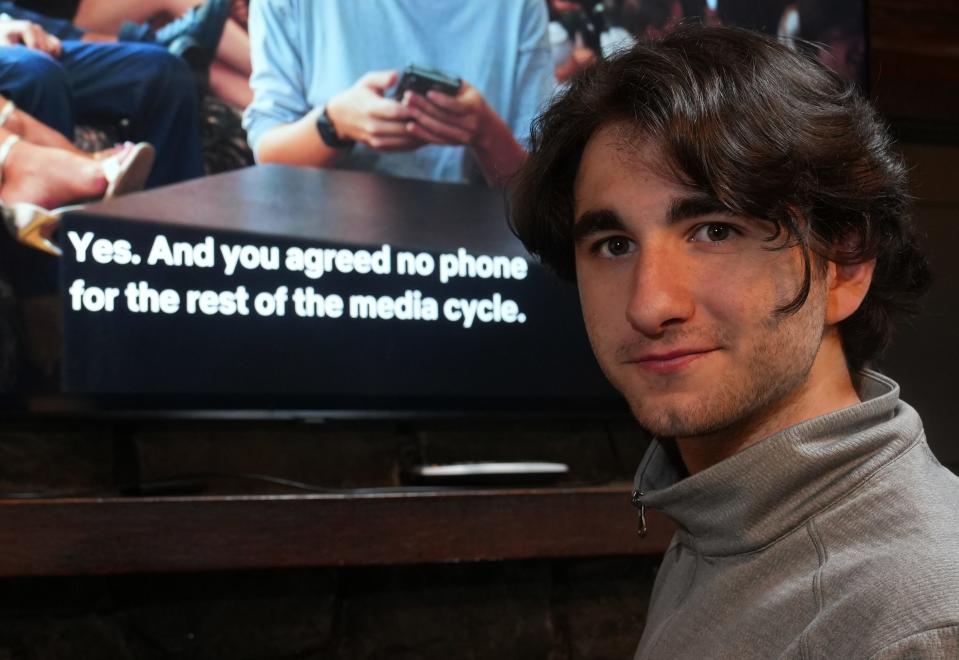Captioning isn't just for those with hearing loss anymore: Why Gen Z loves subtitles
Are captions just for those with hearing loss? Gen Zers and millennials don’t think so.
The two generations “overwhelmingly prefer to watch content with subtitles on,” according to a survey of 1,265 Americans last year by Preply, a language-learning app.
That's no shock to Ringwood’s Liam Fahey, 17. The St. Joseph Regional High School junior “always” has captions on. From soccer games to documentaries, subtitles enrich his content, the teenager said.
“I am very intent on getting every single word and sound effect,” Fahey said. “I don’t want to miss any details.”
These days of seemingly bottomless video content have turned out to be a golden era for closed captioning as well, thanks to technological advances and the surprising demand from young audiences. That's proving to be a boon for people with hearing loss, too, as platforms invest more money to improve both the quality and quantity of subtitles.

Preply, which provides online lessons with foreign language tutors, conducted the survey to figure out why captions are so popular, and the answer largely revolved around how content is being consumed: 89% of people said they opted for subtitles because streaming can muddy dialogue, making movies and TV shows harder to hear.
Tablets and smartphones, meanwhile, have taken entertainment out of the living room and into noisier spaces. Fifty-seven percent of respondents said they watch screens in public, where sound is more disruptive.
Not everyone agrees that captions are the polite way to go, however. Holmdel’s Rylley Vandewettering, 17, said it drives her parents crazy when she enables captions.
“My mom and dad hate it. They always tell me to turn it off,” Vandewettering said. “It distracts them because it takes up part of the screen.”
Her parents aren't alone. Perhaps the most surprising find in Preply's survey was that older respondents, such as Generation X and baby boomers, were the least likely to use subtitles.
Overall, half of respondents said they watched TV with captions "most of the time." The number rose to 70% when it came to Gen Z, the cohort born between 1997 and 2012. Millennials, those born between 1981 and 1996, came in second, opting for onscreen aids 53% of the time.
Book bans: What NJ students think about the books they're required to read
Stagetext, which provides captioning services for live events in England, has documented a similar phenomenon. Four out five viewers between the ages of 18 and 25 use subtitles all or part of the time, and less than a quarter of people between 56 and 75 embrace the technology. The company's chief executive, Melanie Sharpe, chalked it up to experience in a BBC interview: For younger viewers, captions have become the norm.
Hackensack’s Arlene Romoff, a member of the Hearing Loss Association of New Jersey, enjoys the idea of being just another audience member. The 74-year-old has relied on captions since the 1980s. Back then, captioning was provided by specially trained transcribers whose text was broadcast to a decoding device that looked like a second cable box on top of TV sets.
As recently as 1998, people with hearing loss had to search for theaters that showed movies with captions burned into films. The films were typically shown only once a month, Romoff said
Breaking disability’s glass ceiling: Local firm helps workers push beyond low-pay jobs
“The movie theaters had been adamant that there would not be regular open captioning visible to all in a movie theater,” she said. That changed after a 2003 legal settlement required theaters to provide captioning devices to viewers with hearing loss or to show open captioning, which would be visible to all.
Most theaters chose to hand out individual devices, but those came with their own problems, said AnnMarie Bacino, a professor at Kean University who is deaf. Batteries died during films, and keeping one eye on a movie screen and another on a device was exhausting for moviegoers.
In 2011, the National Association of the Deaf sued Netflix over the lack of closed captioning on its shows, saying the company was violating the Americans with Disabilities Act. Netflix countered that the ADA applied only to physical spaces. But a federal judge ruled in 2012 that it would be “irrational" to conclude that “places of public accommodation are limited to actual physical structures."
A decade later, Netflix appears to be embracing accessibility. The streaming giant has been "expanding its audio descriptions, subtitles and dubbing in dozens of languages," according to a May report in TechCrunch. Hulu, Amazon, eBay and other platforms have faced similar lawsuits over online accessibility.
The task has been made easier by advances in artificial intelligence and high-speed internet connections. Online video captions are now ubiquitous and rendered quickly for audiences consuming content on smartphones, tablets, computers and TVs.
On YouTube, for instance, instant, live subtitles were available only for content producers with over 1,000 subscribers. Last year, the company made captioning available on all videos, according to a video by its Creator Tech Team on the platform. Problems caused by a decoder's poor reception or a stenocaptioner's typos are happening less often, according to a Mental Floss article on the history of captioning.
"Anytime there's a mainstream use for access accommodations and devices, it's a win for those of us who need them for basic access," said Romoff.
It's creating "a more inclusive atmosphere," she added. People with hearing loss are not "outsiders" who need special accommodations. They are "just another part of the audience making use of the access to suit our own purposes."
"This is really significant," she said.
Gene Myers covers disability and mental health for NorthJersey.com and the USA TODAY Network. For unlimited access to the most important news from your local community, please subscribe or activate your digital account today.
Email: myers@northjersey.com
Twitter: @myersgene
This article originally appeared on NorthJersey.com: How Gen Z's appetite for captions helps those with hearing loss

